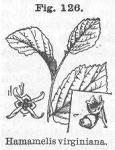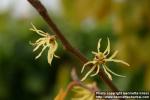
 Preparations: Hamamelis Water - Fluid Extract of Hamamelis
Preparations: Hamamelis Water - Fluid Extract of Hamamelis
The leaves of Hamamelis virginiana, Linné, collected in autumn"—( U. S. P.). also the bark and twigs of same.
Nat. Ord.—Hamamelaceae.
COMMON NAMES: Witch-hazel, Winterbloom, Snapping hazelnut, Spotted alder, etc.
Botanical Source.—This is an indigenous shrub, and consists of several crooked, branching trunks from the same root, from 4 to 6 inches in diameter, 10 or 12 feet in height, and covered with a smooth gray bark. The leaves are borne on short petioles, alternate, oval or obovate, acuminate, obliquely subcordate at base, margin crenate-dentate, scabrous, with minute elevated spots beneath, and from 3 to 5 inches long, two-thirds as wide. The flowers are yellow, on short pedicels 3 or 4 together in an involucrate, axillary, subsessile glomerule. The calyx is small, divided into 4 thick, oval, downy segments, with an involucel of 2 or 3 bracts at base. The petals, 4 in number, are yellow, ¾ of an inch long, linear, curled or twisted. Sterile stamens 4, scale-like, opposite the petals, alternating with the 4 fertile ones. Ovary ovate; styles 2, short; stigmas obtuse. The capsule or pod is nut-like, 2-celled, 2-beaked, opening loculicidally from the top; the outer coat separating from the inner, which incloses the oblong, black seeds, but soon bursts elastically into 2 pieces (W.—G.—R.).
History and Description.—This shrub grows in nearly all parts of the United States, especially in damp woods, flowering from September to November, when the leaves are falling, and maturing its seeds the next summer. The bark and leaves are the parts used in medicine; they possess a degree of fragrance, and, when chewed, are at first somewhat bitter, very sensibly astringent, and then leave a pungent sweetish taste, which remains for a considerable time. Water extracts their virtues. No analysis has been made of the leaves, though they are known to contain a bitter body and tannin. The bark and root probably contain a very small amount of volatile oil (see Drs. J. Marshall and H. C. Wood, in Therap. Gaz., 1886, p. 295). Dr. Charles A. Lee (Jour. Mat. Med., 1859, p. 200) found in the bark 5 ½ per cent of tannin, while H. K. Bowman (Amer. Jour. Pharm., 1869, p. 194) records 8.10 per cent, and Walter B. Cheney (ibid., 1886, p. 418) 6.75 per cent. No glucosid nor alkaloid was obtainable by the latter author or by others. F. Grüttner (Archiv der Pharm., 1898, pp. 278-320) obtained from the bark 3 per cent of a crystallizable and optically active tannin (hamamelitannin, C14H14O9+5H2O), gallic acid, dextrose, fatty and waxy matter, including phytosterin (C26H44O+H2O), etc. A preparation made by distilling water, or water containing some alcohol, from the green twigs and leaves of hamamelis is very popular under the term Distilled Extract of Hamamelis. The U. S. P. describes hamamelis leaves as follows: "Short-petiolate, about 10 Cm. (4 inches) long, obovate or oval, slightly heart-shaped, and oblique at the base, sinuate-toothed, thickish, nearly smooth; inodorous; taste astringent and bitter"—(U. S. P.). The shoots are used is divining-rods to discover water and metals under ground, by certain adepts in the occult arts.
Action, Medical Uses, and Dosage.—Witch-hazel is tonic and astringent. Some have pronounced it sedative also. The decoction of the bark is very useful in hemoptysis, hematemesis, and other hemorrhages, as well as in diarrhoea, dysentery, and excessive mucous discharges, with full, pale, and relaxed tissues. It has been employed with advantage in incipient phthisis; in which it is supposed to unite anodyne influences with its others. It is useful in the form of poultice in swellings and tumors of a painful character, as well as in external inflammations. The American Indians used it for this purpose. The decoction maybe advantageously used as a wash or injection for sore mouth, painful tumors, external inflammations, bowel complaints, prolapsus ani and uteri, leucorrhoea, gleet, and ophthalmia.
Since the introduction of the distilled extract of witch-hazel and the specific hamamelis, the use of decoctions of the bark has been largely abandoned. The fluid extract has but little to recommend it. The articular field for hamamelis is in disorders involving the venous structures. Its most pronounced virtue is its stimulating and tonic action upon the venous coats, exhibited so markedly in its power over varicoses, hemorrhoids, hemorrhages, and other conditions due to relaxation of venous structures. The parts are usually pale and relaxed, though occasionally a deep redness, due to venous engorgement, is observed. Here, and especially as great pain is usually an accompaniment, belladonna may be associated with it. It is adapted to the whole venous system, overcoming debility, differing therein from such agents as act only upon localized vascular areas.
Prof. J. M. Scudder and others have found witch-hazel a valuable remedy in passive hemorrhages and congestion, especially in epistaxis, hemorrhoids, phlegmasia dolens (after acute phases have passed away), phlebitis, and varicose veins. He also found it valuable in diarrhoea, in chronic pharyngitis, and in chronic uterine congestion, where the cervix is enlarged without abnormal hardness, the os uteri being soft, open, and patulous, and perhaps leucorrhoea and some prolapsus present. It is specially adapted to diarrhoea with a tendency to or associated with passive hemorrhage. It also forms an excellent application to chronic vascular conditions of mucous tissues, and to old, flabby, fetid ulcers. Prof. A. J. Howe stated that in "several cases of uterine hemorrhage, all occurring within 2 years, he administered witch-hazel with success. In some instances, the cause of the flow, and the conditions upon which it depended, were unknown or rested on conjecture, yet the exhibition of the medicine was always followed by satisfactory results." Half-teaspoonful doses of specific hamamelis were mixed with water and repeated every few minutes while the flow lasted, and afterward every few hours to prevent a return of the hemorrhage. In menorrhagia and those wasting states so common after abortion, in the early months of pregnancy, he used no remedy that exerted such beneficial effects as witch-hazel. In uterine hemorrhage following delivery at full term, the remedy is probably not equal to ergot, but in the kind of cases referred to it is a safer agent. In chronic diarrhoea and cholera infantum it is a valuable medicine. Hamamelis, both internally and topically, arrests oozing of blood from mucous surfaces. This action is well shown in non-inflammatory hematuria. It is not the remedy for active hemorrhage, but for passive bleeding, as from the lungs, stomach, bowels, renal or genital organs its action is satisfactory.
Besides its control over actual hematuria hamamelis is often serviceable in renal affections due chiefly to vascular relaxation. Thus in diabetes insipidus it has been of some value, but it is of greater service in mucous profluvia of the urino-genital tract. It is of benefit in vesical catarrh, with tenesmus, and in irritation of the bladder, due to enlarged and relaxed scrotal veins. It should be used both internally and locally to the scrotum. While it relieves varicocele, too much must not be expected of it in the way of a cure. In female disorders it is indicated by venous fullness and relaxation. Dull, aching, ovarian pain is relieved by hamamelis, and in leucorrhoea, with fullness of the pelvic veins and relaxation of the uterine and vaginal walls, its internal and external exhibition is of marked benefit. It relieves ovarian and testicular congestion. Hamamelis is of pronounced value in hemorrhages into the eye ball, and locally relieves ecchymosis of the lids and conjunctiva.
Hamamelis is justly popular as a remedy for sprains, contusions, wounds, swellings, etc. A solution of a few grains of asepsin in distilled hamamelis forms an elegant and efficient dressing for burns, scalds, cuts, abrasions, crushed fingers, etc. Ten grains of menthol to 4 fluid ounces of distilled hamamelis are also efficient in burns and scalds (Ellingwood). Glycerin and hamamelis, or Lloyd's hydrastis and hamamelis, equal parts, has rendered us excellent service in irritated and inflammatory conditions of the external auditory meatus, especially when due to irritation from the presence of inspissated cerumen. Locally, hamamelis forms an excellent soothing application for chafing, due to excessive discharges; it is likewise useful in diffusive cutaneous inflammations. Few agents are more grateful in various subacute forms of sore throat, also in sore throat with deep redness and great pain, and it is particularly soothing in scarlatinal angina. It is a very valuable aid, locally, in the treatment of tonsilitis, phlegmonous ulceration of the throat, diphtheria, and acute catarrh. Chronic conjunctivitis, with vascularity of the palpebral and ocular conjunctiva, has yielded to a decoction of equal parts of hamamelis (bark), hydrastis, and lobelia, boiling the first two ingredients, and adding the lobelia to the hot liquid. Cover, allow to cool and strain. Hamamelis should not be neglected as a part of the treatment of inflamed breasts, and applied hot it gives great relief to the soreness of abdominal muscles and pelvic parts following childbirth. Muscular soreness and aching sensations, as of having been bruised, whether from colds, exposures, strains, bruises, or severe muscular action, are greatly relieved by the application of distilled hamamelis, either hot or cold, by means of compresses, while specific hamamelis may be given internally. It forms a good face wash for burning of the skin, for tan and freckles, for dilated facial capillaries, and a good application after shaving. Distilled hamamelis and Lloyd's colorless hydrastis form a safe and efficient injection for most cases of gonorrhoea. Witch-hazel enters into many of the ointments designed for application to piles. An ointment made with lard and a decoction of white oak bark, apple-tree bark, and witch-hazel has been successfully employed for this purpose. Dose of decoction of witch-hazel, from 2 to 4 fluid ounces, 3 or 4 times a day; of distilled hamamelis, 5 to 60 drops; of specific hamamelis, 1 to 30 drops.
Specific Indications and Uses.—Venous debility, with relaxation and fullness; pale mucous tissues (occasionally deep-red from venous engorgement, or deep-blue from venous stasis); mucous profluvia, with venous relaxation; passive hemorrhages; varicoses; capillary stasis; hemorrhoids, with full feeling; relaxed and painful sore throat; dull, aching pain in rectum, pelvis, or female organs; perineal relaxation, with fullness; muscular relaxation; muscular soreness and aching and bruised sensation, whether from cold, exposure, bruises, strains, or from physical exertion.

